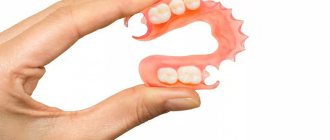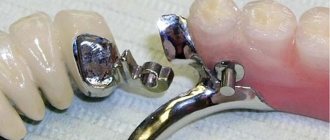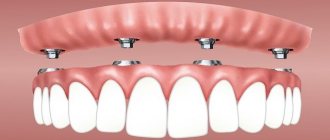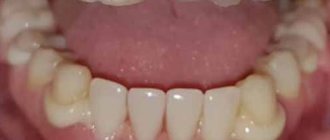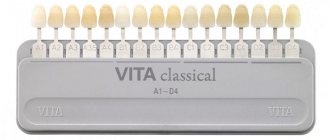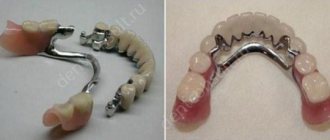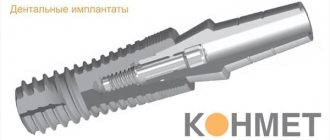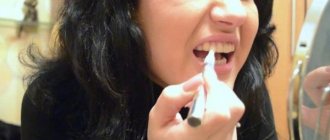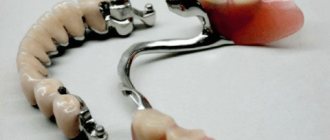Prosthetics teeth – This is the restoration of the functions of the human masticatory apparatus. The best removable dentures – what are they? And by what criteria to choose them? The best decision is to get a detailed consultation with a dentist. However, it doesn’t hurt to know some useful information yourself.
What is edentulism and why is it necessary to install removable dentures as quickly as possible?
tooth loss (partial or complete edentia) can be various diseases. The most common is periodontitis, which is characterized by a long-term inflammatory process in the gum tissue, gradual destruction of the periodontal junction and progressive destruction of the alveolar process.
After the loss of a tooth , the load on the jaw when chewing is redistributed. As a result, in the place where the crown used to be, the gums gradually recede - the spongy tissue becomes thinner. If you don’t consult a doctor in time and end up losing almost all your teeth , there is a high probability that you won’t even be able to install a removable jaw – it simply won’t have anything to cling to. Installing implants in such a situation is also problematic - you will have to build up the bone, and this is time-consuming and expensive.
You should seek dental care at the first signs of periodontitis. If the process is started, the doctor will examine the oral cavity, remove everything that is loose, and offer the patient removable dentures with suction cups or implants .
On a note. it is possible to preserve several dental on at least one jaw , it is possible to install clasps, which have good fixation and are almost not felt in the mouth.
Structural materials in prosthetics
A modern dentist has a sufficient amount of materials for making dentures in his arsenal.
In modern prosthetics, materials such as: Plastic are used. Used for the manufacture of temporary crowns, and removable acrylic and nylon structures. Plastic products do not last long, so they will need to be replaced after a while.
Metal. Gold-containing and cobalt-chromium alloys are widely used. Metal crown frames and clasp dentures are very common.
Zirconium. Zirconium oxide and dioxide are ideal materials for restoring dentition in the chewing area. The ceramic coating of zirconium crowns gives the product a natural shine.
Ceramics. This material is valued for its properties that are as close as possible to natural tooth enamel. For ceramic products, you can easily choose the desired shade. The main disadvantage of ceramics was previously considered to be low strength, but with the beginning of the use of sodium disilicate in prosthetics, this parameter improved. A good example of the use of ceramics is E-Max crowns.
Which dental prosthetics is better and cheaper is a question that only his attending physician can answer for each patient. Much depends on the location of installation - anterior or chewing teeth, the level of qualifications of the specialist and the nuances of a specific clinical situation.
Useful tips for those who have recently installed a prosthesis
Literally from the first days of using a prosthesis, many patients complain of pain, as well as abrasions and scratches in the oral cavity. In fact, mechanical damage should not occur, since this point was thought out at the product design stage. Perhaps you are simply wearing it incorrectly. If the problem does not resolve itself, you need to contact your dentist for further adjustments to the prosthesis.
The tips given below will not completely relieve you of difficulties during the adaptation period, but they will significantly reduce the level of negative impact and will help you get used to the prosthesis faster.
The process of chewing food causes pain, so in the first few weeks it is better to protect yourself from eating solid and tough foods: meat, nuts, cookies, etc. If even soft food is painful to chew, then at first you can cut it into small pieces. Trust your feelings, and when the pain begins to subside, gradually move on to your usual, normal diet.
Under no circumstances should you reduce the number of meals. Most patients, due to a strong fear of getting damage to the oral cavity (and they take a very long time to heal), switch to liquid foods and yoghurts. But this is not the right solution, since in order to get used to the prosthesis, a constant chewing load is needed.
Foods such as pears, apples and citrus fruits should be cut into small pieces and chewed slowly, with great effort. This allows you to reduce the degree of damage to the mucous membrane, and also gives the body all the necessary vitamins.
If you have a dry mouth or increased salivation, it is recommended to drink plenty of liquid in small sips throughout the day.
If you feel slight numbness, you can do a light massage of the gums, this will improve blood circulation and the numbness will go away in just a few minutes. In this case, you need to remove the prosthesis.
Decoctions of herbs such as sage and chamomile will help strengthen your gums and prevent irritation. It is advisable to carry out the procedure three times a day. The decoction should never be hot; liquid at room temperature is the best option.
Prosthetics on implants
Implantation is a modern way to restore teeth. The operation consists of installing titanium pins on which removable or fixed dentures are placed. Implantation can be one- or two-stage.
With a one-stage operation, immediate loading of the implant and installation of artificial teeth is possible. Chewing function and aesthetics are restored immediately.
A two-stage installation requires a recovery period between the installation of the implant and the prosthesis. Complete restoration of chewing function and aesthetics is possible only after the implantation of the structure.
Also, prosthetics on implants can be removable or non-removable.
For removable prosthetics, a two-stage method is used. Abutments are installed only after osseointegration and are selected depending on the type of fastening, which can be locking or beam.
Installing permanent structure on an implant allows you to restore one or more teeth. The implementation of the design can be one-step or stage-by-stage. The non-removable method allows you to install a prosthesis without grinding or any damage to adjacent teeth.
By number of missing teeth
Depending on the number of lost teeth, a specific prosthetic method is selected.
For minor losses in the dentition
It is advisable to use acrylic, clasp and bridge prostheses. The design on implants will also always remain relevant.
With complete edentia
fixed prosthetics will be more effective. The technology of prosthetics on implants “All-on-4” and removable structures on pins are considered the most effective methods of restoring dentition with significant losses. In some cases, the use of economical versions of acrylic or nylon is justified, but due to insufficiently reliable fastening in the oral cavity and uneven load distribution, orthopedists do not recommend them so often.
The latest development - Vertex
Not long ago, the semi-rigid Vertex design was developed, which has already received many positive reviews. The following features can be highlighted:
- The material is characterized by high density and exceptional smoothness.
- The chewing load is evenly distributed on the upper and lower jaws of the product.
- The design is resistant to temperature changes and retains its shape even when eating very hot food.
- The prosthesis does not change color and does not absorb any odors.
- The product does not emit harmful substances and does not contain monomers.
- The models are very resistant to mechanical damage.
Vertex models look like this:
Acrylic
Partially removable
Partially removable
Telescopic and on implants
You can make the design in any of 12 shades:
By mounting method
In modern dentistry, various means of fixation are used. The comfort and duration of getting used to the structure will depend on the chosen method and quality of fastening. The orthopedic surgeon selects specific methods of fixation taking into account the individual clinical situation and the chosen method of prosthetics.
Creams and powders are considered one of the more reliable means of fixing removable dentures. A special product is applied to the denture, which is then pressed tightly to the oral cavity. Creams are recommended for patients with increased salivation, and powders are used for low salivation. If the structure of the jaw is abnormal, orthopedic doctors recommend using fixing strips.
Clasp-type dentures are secured using attachments or clasps. Alveolar processes are also used, which provide additional fixation. When putting on a removable denture, reliable fastening provides a suction effect.
Manufacturing process
The production of acrylic structures is characterized by maximum simplicity. The following stages of product creation can be distinguished:
- In dentistry, the patient is diagnosed with the oral cavity and assessed which prosthetic option will be most suitable.
- If necessary, treatment is carried out. You cannot install a removable structure if there are inflammations or diseases in the mouth.
- The doctor makes a cast of the jaw, which is used to create a plaster model, and then the product itself from acrylic.
- The patient tries on the model. If necessary, it is corrected.
The process of making a prosthesis takes a maximum of 7 days, but the adaptation time to it can last up to 30 days. If a person experiences discomfort, feels strong friction, or feels like the model is not made to fit, you should consult a doctor.
Which prostheses are better according to indications and budget?
An orthopedic surgeon will tell you which dental prosthetics are better and cheaper, and whether it is worth saving on treatment at all in each specific case.
The cost of prosthetics depends on the number of missing teeth, the type of design chosen and the level of qualification of the specialist. As a budget option, a good choice is an acrylic prosthesis; you should not remember about its fragility and possible allergic reaction. It is also worth considering nylon - it is softer and does not rub the gums.
More expensive options are clasp dentures with clasps or locks. In the second case, the fastening will be strong, but invisible in the mouth.
The most expensive designs are ceramic and zirconium. They are distinguished by excellent aesthetics and performance parameters.
Sections we recommend
These articles provide information about acrylic dentures:
- Consultation with an orthopedist
- Removable prosthetics
- Flexible prostheses
Literature used for the article:
- Comparative assessment of prosthetics for patients with complete removable acrylic dentures / M.I. Sadykov, A.G. Nugumanov. ― Irkutsk: Siberian Medical Journal, 2012
- Current state of the issue of choosing a material for orthopedic treatment of patients in need of removable prosthetics / V.A. Klemin, A.A. Vorozhko.― Far Eastern Medical Journal, 2015.
Author of the article: Natalya Aleksandrovna Kozlova
Copywriter of the information portal Stom-Firms.ru. Specializes in medical and dental texts.
FAQ
— Should I be afraid of allergic reactions?
An allergy to dentures is possible, but it is quite rare. Before installation, the patient undergoes a predisposition test. Based on the results of a vegetative resonance study, an orthopedic doctor determines sensitivity to various materials used in prosthetics. This method is 90% reliable.
— Is it necessary to use fixing compounds when wearing removable dentures?
Removable structures are “sucked” to the surface of the oral cavity, but for additional fixation you can optionally use creams or powders.
— Is it possible to sleep with removable dentures?
In the first 2-3 weeks, dentists even recommend not removing the structure at night in order to speed up the adaptation process. After the adaptation period, the choice remains with the patient himself - place the prosthesis in a special solution before going to bed or leave it in the mouth.
— When there are no teeth at all, which prosthesis is better to put in?
For complete edentia, the best option is fixed dentures on implants or prosthetics using the All-on-4 method. High aesthetics and durability will be important advantages. As an economical option, you can consider an acrylic prosthesis or acry-free.
Acry-Free removable dentures
A good alternative to acrylic - they have some flexibility, are much lighter, and nylon - they are quite durable, weigh more, so they distribute the load well when chewing. The material is chemically neutral and does not cause allergies, although it is an acrylic resin, albeit without monomers.
Acry-Free removable dentures
- High aesthetics - invisible, very natural. Dental units are made from high-quality plastic or ceramics.
- Fast adaptation. The structure hardly shrinks.
- Provide reliable fixation .
- Suitable for any patient, including those with allergies to acrylic.
- Provide high-quality chewing - fit well to the gums.
- On average, they last as long as acrylic ones - 7 years.
- Accepts coffee, tea and other coloring products - less susceptible to discoloration than acrylic and nylon.
- Easily repaired.
